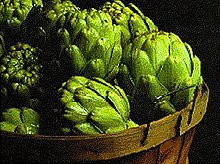Artichoke
| Globe Artichoke | |
|---|---|

| |
| Globe Artichoke buds ready for cooking | |
| Scientific classification | |
| Kingdom: | |
| Division: | |
| Class: | |
| Order: | |
| Family: | |
| Genus: | |
| Species: | C. scolymus
|
| Binomial name | |
| Cynara scolymus | |
The Globe Artichoke (Cynara scolymus) is a perennial thistle originating in southern Europe around the Mediterranean. It grows to 1.5-2 m tall, with arching, deeply lobed, silvery glaucous-green leaves 50–80 cm long. The flowers develop in a large head from an edible bud about 8–15 cm diameter with numerous triangular scales; the individual florets are purple. The edible portion of the buds consists primarily of the fleshy lower portions of the involucral bracts and the base, known as the "heart"; the mass of inedible immature florets in the center of the bud are called the "choke."
Cultivation


Globe Artichokes were first cultivated at Naples around the middle of the 15th century, and are said to have been introduced to France by Catherine de' Medici, Dutch introduced artichokes to England, where they were growing in Henry VIII's garden at Newhall in 1530. They were introduced to the United States in the 19th century, to Louisiana by French immigrants and to California by Spanish immigrants. The name has originated from ardi shauki (أرضي شوكي), which is Arabic for ground-thorn, through the Italian, articiocco.
Today, the Globe Artichoke is cultivated mainly in France, Italy, and Spain. In the United States, California provides nearly 100% of the U.S. crop, and approximately 80 percent of that is grown in Monterey County; there, Castroville proclaims itself to be "The Artichoke Center of the World". The cultivar 'Green Globe' is virtually the only kind grown commercially in the U.S.

Globe Artichokes are perennials, and produce the edible flower only during the second and subsequent year. Commercial culture is limited to warm areas in USDA hardiness zone 7 and above. It requires good soil, regular watering and feeding plus frost protection in winter. Rooted suckers can be planted each year so that mature specimens can be disposed of after a few years, as each individual plant only lives a few years. The peak season for artichoke harvesting is the spring, but they continue to be harvested throughout the summer, with another peak period in mid autumn.
When harvesting, if they are cut from the ground so as to leave an inch or two of stem, artichokes possess good keeping qualities, frequently remaining quite fresh for two weeks or longer under average retail conditions.
The recently introduced hybrid cultivar 'Imperial Star' has been bred to produce in the first year without such measures. An even newer cultivar, 'Northern Star', is said to be able to overwinter in more northerly climates, and readily survive sub-zero temperatures.
Apart from food use, the Globe Artichoke is also an attractive plant for its bright floral display, sometimes grown in herbaceous borders for its bold foliage and large purple flowerheads.
Uses

Cooking
Whole Globe Artichokes are prepared for cooking by removing all but 5–10 mm or so of the stem, and (optionally) cutting away about a quarter of each scale with scissors. This removes the thorns that can interfere with handling the leaves when eating. Then, the artichoke is boiled or steamed until tender, about 15–45 minutes. If boiling, salt can be added to the water, if desired. It may be preferable not to cover the pot while the artichokes are boiled, so that the acids will boil out into the air. Covered artichokes can turn brown due to the acids and chlorophyll oxidation.
The leaves are often removed and eaten one at a time, sometimes dipped in butter, mayonnaise, aioli, or other sauces.
Tea
Artichokes can also be made into an herbal tea; artichoke tea is produced as a commercial product in the Dalat region of Vietnam.photo[1]
Liquor
Artichoke is the primary flavor of the Italian liquor Cynar.
Ethnomedical Uses
Dried or fresh leaves and/or stems of Cynara are used as a choleretic (to increase bile production), to treat gallstones, and as a tonic for convalescence.
Cynarin is the principal active constituent in Cynara; research in 2005 found that cynarin causes an increase in bile flow[1].
References
- ^ 1
 This article incorporates text from a publication now in the public domain: Ward, Artemas (1911). "The Grocer's Encyclopedia". The Grocer's Encyclopedia.
This article incorporates text from a publication now in the public domain: Ward, Artemas (1911). "The Grocer's Encyclopedia". The Grocer's Encyclopedia.
External links
- Cynara scolymus - Plants for a Future database entry
- History of the Artichoke - plus miscellaneous facts
- Developed from Cardoon? (this article is currently—as of 30 March 2007—unavailable, but will supposedly return)
- Artichokes - page of links to artichoke articles at UC Davis Vegetable Research & Information Center
- Globe Artichoke - Commercial Vegetable Production Guide, Oregon State University
- Grilled Artichokes - a photo-illustrated guide to cooking and eating artichokes
- Artichoke recipes - from the Artichoke Advisory Board of California
- Nutrition facts
- How to Cook and Eat an Artichoke - step-by-step instructions with photos
- [2]
